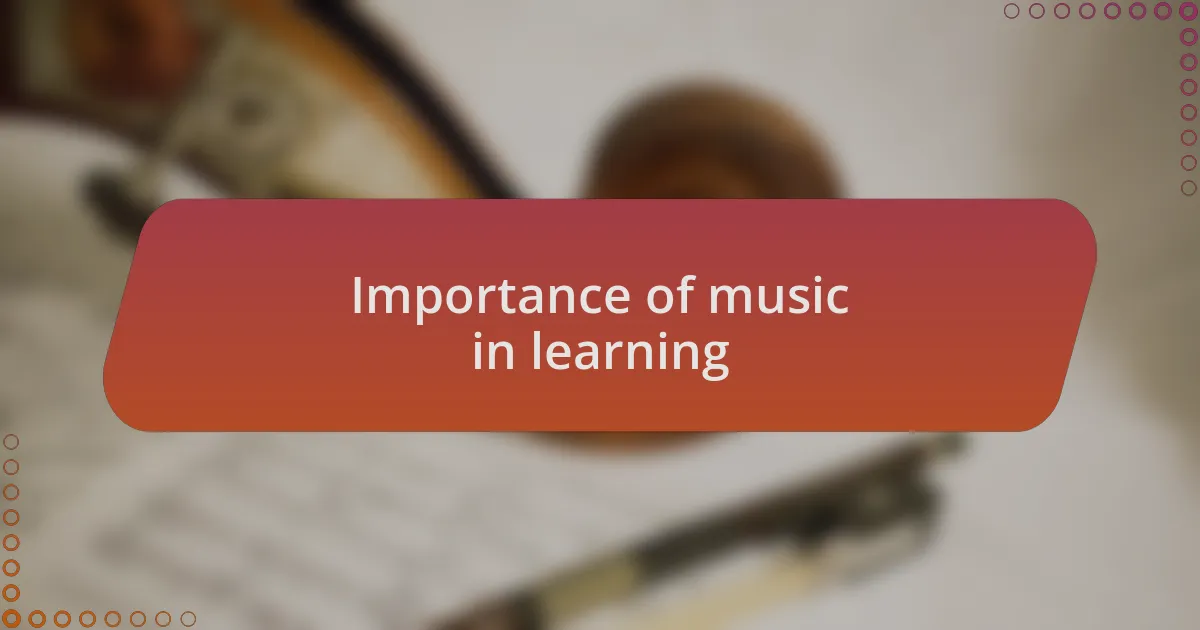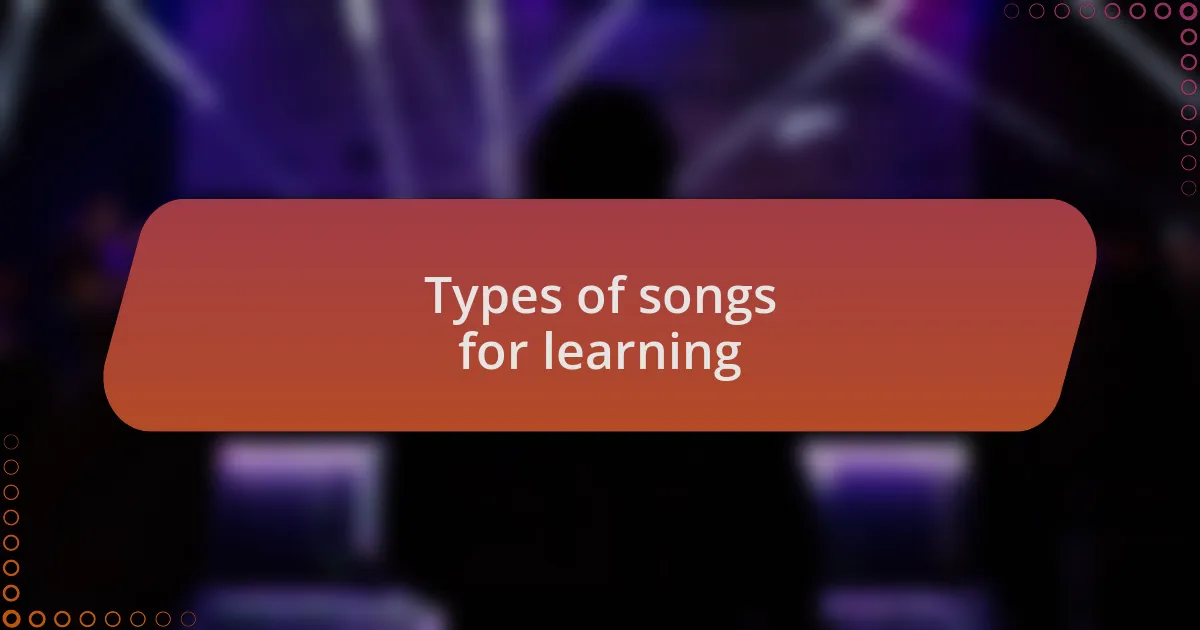Key takeaways:
- Children’s music aids in emotional and cognitive development, fostering language skills and emotional intelligence through engaging melodies and themes.
- Incorporating music into daily routines enhances learning experiences, making tasks enjoyable and encouraging curiosity and participation.
- Different types of songs serve specific learning goals, such as nursery rhymes for vocabulary, educational songs for academic subjects, and emotional themes to facilitate discussions about feelings.
- Personal experiences with music highlight its ability to transform mundane moments into opportunities for creativity, learning, and connection.
Understanding children’s music
Understanding children’s music requires more than a casual listen; it taps into their emotional and cognitive development. I recall listening to rhythmic songs with my niece as she danced around the living room, her giggles filling the space. It struck me how these simple melodies were not just entertaining her but also helping her build essential language skills and rhythms that would support her future learning.
When I think about why certain tunes stick with children, I consider the vibrant melodies and relatable themes. Have you noticed how children respond to repetitive phrases or catchy hooks? I remember singing those infectious nursery rhymes with my own kids, watching them light up at the familiar tunes. It was clear that these songs were fostering a sense of community and shared experience, something crucial for their emotional growth.
Interestingly, children’s music serves as a gateway to explore complex subjects like empathy and diversity. I often use songs from different cultures to broaden my children’s perspectives, sparking conversations about traditions and values. This approach not only enriches their understanding but also cultivates an appreciation for the world around them, shaping their identities as empathetic individuals.

Importance of music in learning
Music plays an essential role in enhancing memory retention and cognitive skills in children. I often find myself amazed at how a simple song can help my kids remember facts, from counting to the alphabet. When my son learned his times tables through a catchy tune, it was like watching a light bulb go off in his head. Who knew learning could be so fun?
In my experience, music not only aids in academic learning but also nurtures emotional intelligence. I remember a time when my daughter was feeling down, and I played her favorite upbeat song. It transformed her mood almost instantly and opened the door for a heartfelt conversation about feelings. Isn’t it remarkable how melodies can bridge emotional gaps and foster deeper connections?
Furthermore, incorporating music into learning creates an interactive experience for children that reinforces participation. I’ve found that when I use songs during activities, my kids are more engaged and eager to participate. Whether we’re singing about nature while on a walk or creating a story through music, the learning becomes dynamic and memorable. How powerful is it that a song can turn a mundane lesson into an exciting adventure?

Types of songs for learning
When considering the types of songs for learning, I’ve found that nursery rhymes hold a special place. They are simple, repetitive, and filled with rhythm, which makes it easier for young children to grasp new words and concepts. I recall singing “Twinkle, Twinkle, Little Star” with my daughter as she navigated her early language skills; it not only entertained her but also expanded her vocabulary without the pressure of traditional learning.
Then there are educational songs specifically designed to teach subjects like math, science, or history. I remember discovering a spirited song about the planets that my son adored. Each time it played, he would dance and sing along, effortlessly memorizing the names and order of the planets. Isn’t it fascinating how a catchy melody can transform a complex subject into something enjoyable and memorable?
Finally, songs with emotional themes can also be powerful tools for learning. I often play music that addresses feelings or social situations, like songs about sharing or kindness. One time, after listening to a song about friendship, my kids had a heartfelt discussion about what it means to be a good friend. Can you believe how music sparks these vital conversations and helps children navigate their emotions?

Selecting songs for different skills
When selecting songs for different skills, I focus on the specific learning goals I want to achieve. For instance, when I want to enhance my children’s memory skills, I turn to songs that incorporate repetition and rhyming patterns. I remember one time choosing a song about the months of the year; it was amazing to see how quickly they memorized the order, simply by enjoying the beat and rhythm of the melody.
For introducing new concepts, I often opt for songs that incorporate storytelling elements. I found a delightful tune about a curious little caterpillar, and not only did it pique my children’s interest in nature, but it also ignited conversations about growth and change. How often do we underestimate the power of narrative in making learning relatable and enjoyable?
Additionally, I like to use songs that encourage physical movement to teach coordination and rhythm. One day, we stumbled upon an upbeat song that invited kids to jump, clap, and spin at various moments. Watching my little ones follow along not only improved their motor skills but also filled our home with laughter. Isn’t it remarkable how movement paired with music makes learning feel like play?

Incorporating music into daily routines
Incorporating music into our daily routines has truly transformed the way my children engage with learning. I started with simple songs during our morning rituals, like brushing teeth or getting dressed. These catchy tunes not only made these tasks enjoyable but also fostered a sense of independence as my kids began to hum along and even time their actions to the beat.
During mealtime, I often introduce themed songs that relate to what we’re eating. For instance, one time I played a fun, bouncy song about fruits and vegetables while we prepared a salad together. I noticed how my children became more curious about the ingredients, asking questions about where they come from, which made the whole experience educational and exciting. Have you ever seen how a spark of curiosity can lead to a feast of conversations?
On quieter afternoons, I like to play soothing music during reading time. I remember one instance when I played gentle melodies while we curled up with picture books. The calming tunes not only set a peaceful atmosphere but also seemed to enhance their focus, allowing them to dive deeper into the stories. Isn’t it fascinating how music can create a backdrop for learning and exploration?

Personal experiences with songs
There was a time when I noticed my children singing a catchy tune from a popular kids’ show. I couldn’t help but join in, and soon, we were creating our own verses about everyday activities. That experience showed me how songs not only sparked joy but also offered a platform for creativity and language development. Have you ever thought about how a simple melody can turn into a brainstorming session?
One day, while driving to the park, I played a song that introduced the days of the week. I casually sang along, and to my surprise, my youngest chimed in, proudly counting the days with me. It was a spontaneous moment that turned a mundane car ride into an opportunity for learning. Isn’t it incredible how a catchy song can make complex concepts feel accessible?
I recall one rainy afternoon when we crafted a little song about the weather. Using a simple tune, we made up lyrics about sunshine, rain, and clouds. Not only did it bring laughter, but I also saw their understanding of weather patterns flourish. How does something so playful remind us of the beauty of learning through music?